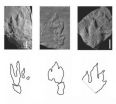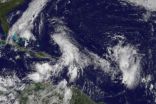1. Antarctic sea ice increase not linked to ozone hole
While sea ice extent has declined dramatically in the Arctic in recent years, it has increased slightly in the Antarctic. Some scientists have suggested that increased Antarctic sea ice extent can be explained by the ozone hole over Antarctica. Previous simulations have indicated that the ozone hole induces a large change in atmospheric circulation in austral summer and that this change in circulation could contribute to the changing Antarctic sea extent.
To learn more, Sigmond and Fyfe use a climate model, forced by monthly varying observed stratospheric ozone changes from 1979 to 2005, to simulate the effects of stratospheric ozone depletion on Antarctic sea ice extent. Contrary to predictions of previous studies, their model finds that ozone depletion would lead to a year-round decrease in Antarctic sea ice extent rather than the increase that was observed. The results suggest that processes other than ozone depletion must be causing the observed increase in Antarctic sea ice extent. It remains unclear why Southern Hemisphere sea ice trends differ so greatly from Northern Hemisphere trends.
Title: Has the ozone hole contributed to increased Antarctic sea ice extent?
Authors: M. Sigmond: Department of Physics, University of Toronto, Toronto, Ontario, Canada;
J. C. Fyfe: Canadian Centre for Climate Modelling and Analysis, Environment Canada, Victoria, British Columbia, Canada.
Source: Geophysical Research Letters, doi:10.1029/2010GL044301, 2010 http://dx.doi.org/10.1029/2010GL044301
2. Lunar topography gets closer look
Selection of landing sites for potential human or robotic lunar missions requires precise knowledge of lunar topography. Contributing to that knowledge, Smith et al. present initial observations from the Lunar Orbiter Laser Altimeter (LOLA) on board the Lunar Reconnaissance Orbiter. The LOLA measurements provide a high-resolution global model of lunar topography based on more observations and observations with greater accuracy than previous lunar topography maps. LOLA also collected high-resolution data on the slope, roughness, and reflectance of the lunar surface.
Title: Initial observations from the Lunar Orbiter Laser Altimeter (LOLA)
Authors: David E. Smith: Department of Earth, Atmospheric and Planetary Sciences, Massachusetts Institute of Technology, Cambridge, Massachusetts, USA and Solar System Exploration Division, NASA Goddard Space Flight Center, Greenbelt, Maryland, USA;
Maria T. Zuber: Department of Earth, Atmospheric and Planetary Sciences, Massachusetts Institute of Technology, Cambridge, Massachusetts, USA;
Gregory A. Neumann, Frank G. Lemoine, and Erwan Mazarico: Solar System Exploration Division, NASA Goddard Space Flight Center, Greenbelt, Maryland, USA;
…
(For listing of all 20 authors, please see abstract at link below.)
Source: Geophysical Research Letters, doi:10.1029/2010GL043751, 2010 http://dx.doi.org/10.1029/2010GL043751
3. Earth's rotation affects flows in submarine channels
Coriolis forces due to the Earth's rotation deflect winds and ocean flows to the right in the Northern Hemisphere and to the left in the Southern Hemisphere. In sinuous submarine channels, Coriolis forces can drive secondary circulation of turbidity currents and determine where erosion and sediment deposition occur. Cossu and Wells conducted laboratory experiments with a channel in a rotating tank to study the conditions under which Coriolis forces dominate the channel flow and to investigate how these forces affect sediment deposition in large-scale submarine channels.
They find that channels at high latitudes and those with large bends are dominated by Coriolis forces, while channels at lower latitudes and those with smaller, tighter bends are less influenced by Coriolis forces. The researchers also show how Coriolis forces affect secondary circulation in successive bends of a sinuous channel. In Northern Hemisphere channels dominated by Coriolis forces, flow is directed toward the outer bank when the channel turns left and toward the inner bank when the channel turns right. In channels where the Coriolis force does not dominate, centrifugal forces direct flow toward the outer bank at all turns in the channel, regardless of the direction of the turn. These forces affect where sedimentation and erosion occur and contribute to the shape and levee asymmetry of the channel.
Title:
Coriolis forces influence the secondary circulation of gravity currents flowing in large-scale sinuous submarine channel systems
Authors:
Remo Cossu, Department of Geology, University of Toronto, Toronto, Ontario, Canada;
Mathew Wells, Department of Physical & Environmental Sciences, University of Toronto, Toronto, Ontario, Canada.
Source:
Geophysical Research Letters, doi:10.1029/2010GL044296, 2010 http://dx.doi.org/10.1029/2010GL044296
4. No lightning detected on Mars during 5-year search
It has been suggested that dust storms on Mars might generate electric fields large enough to produce lightning-like electrical discharges, and a recent study reported evidence of such lightning. If lightning does occur on Mars, it could present a hazard for spacecraft or manned missions to the planet. However, Gurnett et al. report that a 5-year search using a radar receiver on board the Mars Express spacecraft finds no evidence of lightning at frequencies between 4.0 and 5.5 megahertz, although there were two major dust storms and many smaller storms during the time period. The search does not rule out the possibility of lightning on Mars at substantially higher or lower frequencies.
Title:
Non-detection of impulsive radio signals from lightning in Martian dust storms using the radar receiver on the Mars Express spacecraft
Authors:
D. A. Gurnett, D. D. Morgan, and L. J. Granroth: Department of Physics and Astronomy, University of Iowa, Iowa City, Iowa, USA;
B. A. Cantor: Malin Space Science Systems, Inc., San Diego, California, USA;
W. M. Farrell and J. R. Espley: NASA Goddard Spaceflight Center, Greenbelt, Maryland, USA.
Source:
Geophysical Research Letters, doi:10.1029/2010GL044368, 2010
http://dx.doi.org/10.1029/2010GL044368
5. Teasing out aerosol influences on precipitation
Aerosol particles such as dust, smog, smoke, and oceanic haze play an important role in the physics of cloud generation—with all other factors fixed, an increase in aerosol concentrations results in more numerous but smaller water droplets within clouds. Further, high concentrations of aerosols make it harder for cloud droplets to coalesce into larger droplets, thus suppressing the ability of clouds to form rain. But the nature and magnitude of this effect are highly uncertain, making it difficult to model how increased pollution levels will affect rain patterns.
Sorooshian et al. suggest that determining how aerosols influence clouds becomes easier to quantify if observations are classified into two categories: how aerosols interact with clouds, and how clouds form precipitation. This split allows for each process to be weighed against other meteorological factors that could mask the response of clouds to aerosols. Through testing this method with data from satellites, aircraft, and other models, the authors find that splitting cloud behavior into different components helps increase the certainty with which scientists can say that specific perturbations in aerosol levels are linked to changes in precipitation.
Title:
Deconstructing the precipitation susceptibility construct: Improving methodology for aerosol-cloud precipitation studies
Authors:
Armin Sorooshian: Department of Chemical and Environmental Engineering, University of Arizona, Tucson, Arizona, USA; also at Department of Atmospheric Sciences, University of Arizona, Tucson, Arizona, USA;
Graham Feingold and Hongli Jiang: Earth Systems Research Laboratory, U.S. National Oceanic and Atmospheric Administration. Boulder, Colorado, USA;
Matthew D. Lebsock and Graeme L. Stephens: Department of Atmospheric Sciences, Colorado State University, Fort Collins, Colorado, USA.
Source:
Journal of Geophysical Research-Atmospheres, doi:10.1029/2009JD013426, 2010
http://dx.doi.org/10.1029/2009JD013426
6. Magma chamber imaged under ancient Indonesian caldera
The Toba caldera in northern Sumatra, Indonesia, was formed about 75,000 years ago by an enormous explosive volcanic eruption that had significant effect on global climate. To learn more about its underlying crustal structure, Stankiewicz et al. create a three-dimensional image of the magma chamber underneath the lake using a technique called ambient noise tomography, which they apply to seismic noise data recorded by an array of 40 stations around Lake Toba between May and October 2008. In addition to demonstrating the use of this recently developed imaging method, the study confirms that the geometry of the magma chamber under the Toba caldera is complex, with at least two separate subchambers.
Title:
Lake Toba volcano magma chamber imaged by ambient seismic noise tomography
Authors:
Jacek Stankiewicz, Trond Ryberg, and Christian Haberland: Deutsches GeoForschungsZentrum GFZ, Telegrafenberg 14473 Potsdam, Section 2.2, Germany;
Fauzi: Meteorological, Climatological and Geophysical Agency (BMKG), Jakarta, Indonesia;
Danny Natawidjaja: Indonesian Institute of Sciences (LIPI), Bandung, Indonesia.
Source:
Geophysical Research Letters, doi:10.1029/2010GL044211, 2010
http://dx.doi.org/10.1029/2010GL044211
7. Modeling ionospheric variations
Plasma density irregularities in the ionosphere are important to understand and predict because they can cause radio scintillation that affects communications and navigation systems. During an ionospheric phenomenon known as equatorial spread F, or ESF, large-scale electron density bubbles can be generated and rise to high altitudes. Researchers would like to understand the day-to-day variability of ESF, but these variations are driven by complex processes and can be difficult to model. Huba and Joyce create a three-dimensional global model of the onset and evolution of ESF. They show that ESF can be triggered by presunset ionospheric density perturbations and that an existing ESF plasma bubble can trigger a new bubble.
Title:
Global modeling of equatorial plasma bubbles
Authors:
J.D. Huba: Plasma Physics Division, Naval Research Laboratory, Washington, DC, USA;
G. Joyce: Icarus Research, Inc., Bethesda, MD, USA.
Source:
Geophysical Research Letters, doi:10.1029/2010GL044281, 2010
http://dx.doi.org/10.1029/2010GL044281
8. A less invasive method to measure groundwater permeability
Hydraulic conductivity quantifies how easily water moves through aquifers, a factor important for management of water resources, the design of wells, and remediation of contaminated sites. It typically shows strong spatial fluctuations, so determining hydraulic conductivity usually involves extensive, invasive, and often expensive installation of wells or sampling sites within the aquifer.
Pollock and Cirpka have come up with an alternative method. They inject a salt solution into the subsurface, thus changing its electrical properties. The propagation of the solution through the aquifer can then be followed by electrical measurements scattered over the survey area. By innovatively coupling the system of groundwater flow, solute transport, and electrical currents, they can directly deduce the spatial distribution of hydraulic conductivity in the aquifer, and also resolve fine-scale features without major invasions into the subsurface.
Title:
Fully coupled hydrogeophysical inversion of synthetic salt tracer experiments
Authors:
Davina Pollock: Center for Applied Geoscience, University of Tübingen, Tübingen, Germany; also at Department of Environmental Sciences, Swiss Federal Institute of Technology, Zurich, Switzerland;
Olaf A. Cirpka: Center for Applied Geoscience, University of Tübingen, Tübingen, Germany.
Source:
Water Resources Research, doi:10.1029/2009WR008575, 2010
http://dx.doi.org/10.1029/2009WR008575
9. Ocean color affects tropical cyclone formation
The color of the ocean can alter the frequency of tropical cyclones, according to a recent study. The absorption of sunlight is affected by the concentration of chlorophyll, with the Sun's heat penetrating deeper in clear, low-chlorophyll waters. In ocean gyres, this heat can get carried away, so that lower concentrations of chlorophyll are associated with colder surface waters. Ocean surface temperatures can affect atmospheric circulation patterns, and thus the formation of cyclones and other weather patterns.
Gnanadesikan et al. use a coupled climate model to study how chlorophyll levels could affect tropical cyclones. They simulate the formation rate of cyclones in the subtropical North Pacific under scenarios with current chlorophyll levels, with half of current chlorophyll levels, and with no chlorophyll. They find that reducing chlorophyll focused the paths of cyclones along the equator. Eliminating all chlorophyll would reduce tropical cyclone activity poleward of 15 degrees North latitude by two thirds.
Although a no-chlorophyll scenario is extreme, the researchers note other research suggesting that 1960s chlorophyll levels in the Pacific were about 50 percent lower than at present. As tropical cyclone activity has increased since that time, they suggest that ocean color could be a factor that should be taken into account in explaining and predicting such changes.
See 13 August press release at:
http://www.agu.org/news/press/pr_archives/2010/2010-25.shtml
Title:
How ocean color can steer Pacific tropical cyclones
Authors:
Anand Gnanadesikan: Geophysical Fluid Dynamics Laboratory, NOAA,
Princeton, New Jersey, USA;
Kerry Emanuel:Department of Earth, Atmosphere and Planetary Sciences, Massachusetts Institute of Technology, Cambridge, Massachusetts, USA;
Gabriel A. Vecchi, Whit G. Anderson, and Robert Hallberg: Geophysical Fluid Dynamics Laboratory, NOAA, Princeton, New Jersey, USA.
Source:
Geophysical Research Letters, doi:10.1029/2010GL044514, 2010
http://dx.doi.org/10.1029/2010GL044514
10. Simulations show deep oil from leak confined to Gulf of Mexico
The Deepwater Horizon oil leak was one of the largest environmental disasters in recent history, and aspects of its environmental impact are still unknown. In addition to surface oil slicks, large underwater plumes of oil were found. To help evaluate the potential environmental impact, Adcroft et al. ran simulations of underwater plumes of dissolved and suspended oil originating from a point source in the Gulf of Mexico. They assess dispersal and decay mechanisms, examining the possibility that toxic concentrations of dissolved oil might exit the Gulf of Mexico. They find that when ocean circulation and microbial oxidation rates are taken into account, toxic levels of dissolved oil were confined to the northern Gulf of Mexico, indicating that the environmental impact would be limited to that area.
See 19 August press release at:
http://www.agu.org/news/press/pr_archives/2010/2010-26.shtml
Title:
Simulations of underwater plumes of dissolved oil in the Gulf of Mexico
Authors:
Alistair Adcroft: Program in Atmospheric and Oceanic Sciences, Princeton University, Princeton, New Jersey, USA and Geophysical Fluid Dynamics Laboratory, NOAA, Princeton, New Jersey, USA;
Robert Hallberg, John P. Dunne, and Bonita L. Samuels: Geophysical Fluid Dynamics Laboratory, NOAA, Princeton, New Jersey, USA;
J. A. Galt, Christopher H. Barker, and Debra Payton: Office of Response and Restoration, NOAA, Seattle, Washington, USA.
Source:
Geophysical Research Letters, doi:10.1029/2010GL044689, 2010 http://dx.doi.org/10.1029/2010GL044689
11. Limiting global warming might not limit heatwave risk
Recent policy discussions on climate change have focused on limiting global average temperature increases. For instance, the European Union has set a goal of limiting global warming to 2 degrees Celsius (3.6 degrees Fahrenheit). However, this goal represents a global average—regional and local temperature changes may vary, and substantial increases in regional extreme heat events could occur, possibly with serious consequences for some communities. To help inform discussion, Clark et al. used an ensemble of climate simulations to study the potential increase in extreme heat waves under a scenario in which global warming is limited. They found that even if average warming is limited to 2 degrees C, estimated increases in temperature during the hottest days range from 2 degrees C to 6 degrees C (11 degrees F) for parts of Europe, North America, and Asia. The researchers also investigate the sources of uncertainty in estimates of regional changes.
See 17 August post on AGU's Geospace blog at:
http://blog.agu.org/geospace/2010/08/17/dangerous-heat-waves-to-worsen-even-with-strong-climate-action/
Title:
Do global warming targets limit heatwave risk?
Authors:
Robin T. Clark, James M. Murphy, Simon J. Brown: Met Office Hadley Centre, Exeter, UK.
Source:
Geophysical Research Letters, doi:10.1029/2010GL043898, 2010 http://dx.doi.org/10.1029/2010GL043898
###
Anyone may read the scientific abstract for any already-published paper by clicking on the link provided at the end of each Highlight. You can also read the abstract by going to http://www.agu.org/pubs/search_options.shtml and inserting into the search engine the full doi (digital object identifier), e.g. 10.1029/2010GL044301. The doi is found at the end of each Highlight above.
Journalists and public information officers (PIOs) at educational or scientific institutions, who are registered with AGU, also may download papers cited in this release by clicking on the links above. Instructions for members of the news media, PIOs, and the public for downloading or ordering the full text of any research paper summarized above are available at http://www.agu.org/news/press/papers.shtml.
END



